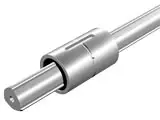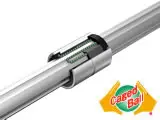THK Ball Spline (full ball type) represents a precision linear motion component engineered to simultaneously transmit torque and accommodate linear movement with exceptional rigidity and minimal backlash. Unlike conventional splines or keyways that rely on sliding contact, this design incorporates a full complement of precision-ground balls circulating between the spline shaft and nut. This rolling contact mechanism fundamentally eliminates stick-slip motion, ensuring smooth, consistent operation even under high loads or at low speeds. The spline shaft features precisely machined helical raceways, while the nut houses a recirculating ball circuit that allows for infinite linear travel. This full-ball configuration maximizes the number of load-bearing elements, directly enhancing moment load capacity and torsional stiffness.
Key technical features include its ability to handle significant torque loads while maintaining precise linear guidance. The hardened and ground spline shaft, typically manufactured from high-carbon chromium bearing steel, ensures exceptional wear resistance and long-term dimensional stability. The nut assembly incorporates a compact, efficient recirculation system that maintains ball orientation and minimizes friction-induced heat generation. Sealing elements are integrated to protect the ball tracks from contaminants like dust, chips, or moisture, which is critical for maintaining performance in harsh industrial environments. Optional configurations include flange-mounted or cylindrical nut styles, allowing for versatile integration into various mechanical designs.
Performance advantages are substantial, primarily centered on high positional accuracy and rotational precision. The near-zero backlash characteristic is vital for applications requiring repeatable indexing or precise angular positioning. Its high rigidity enables it to withstand substantial overturning moments, making it far more stable under complex loading than alternative motion systems. Efficiency is another hallmark; the low friction coefficient of the rolling balls reduces power consumption and minimizes heat buildup, even during high-speed reciprocation or continuous rotation. This efficiency translates directly into higher operational speeds, reduced energy costs, and extended service life with minimal maintenance requirements.
Typical applications leverage these capabilities across demanding sectors. In industrial automation, these ball splines are integral to robot arm joints, providing the necessary torque transmission for rotation while allowing the linear adjustment of the arm's reach. They are found in automatic tool changers on CNC machining centers, where precise angular orientation and rapid linear movement are essential for productivity. Within the automotive manufacturing industry, they drive the precise positioning systems in welding robots and are used in transfer lines for component handling. For precision equipment, they enable the accurate linear and rotational movements in optical alignment stages, semiconductor wafer handling robots, and precision measuring instruments. Any application demanding synchronized rotary and linear motion with high accuracy, rigidity, and reliability is a candidate for the THK Ball Spline (full ball type).
THK Ball Spline Caged Ball Spline represents a sophisticated evolution in linear motion technology, engineered to transmit torque while accommodating linear movement with exceptional precision and rigidity. This specialized component integrates a unique caged ball design where precision-ground balls are retained within a cage structure, preventing direct ball-to-ball contact and minimizing friction, heat generation, and wear. The spline shaft features precisely machined grooves that engage with the caged ball assembly, ensuring smooth, reliable motion transfer under high loads and rotational speeds. Available in various configurations, including standard, flange, and support unit types, these ball splines cater to diverse mounting and operational requirements across industrial applications.
Key technical features distinguish the THK Caged Ball Spline for demanding environments. Its caged structure eliminates the need for ball recirculation, reducing noise and vibration while maintaining consistent lubrication distribution. The design incorporates high-carbon chromium bearing steel for shafts and alloy steel for housings, providing superior hardness, corrosion resistance, and durability. Precision grinding of groove profiles ensures minimal backlash and high positional accuracy, with options for preloading to further enhance rigidity. Sealing systems, often including multi-lip seals or scraper rings, protect against contaminants like dust, chips, and moisture, extending service life in harsh conditions. These splines support high torque capacities and moment loads, with dynamic load ratings optimized for continuous operation in automated systems.
Performance advantages make this component indispensable for applications requiring simultaneous rotary and linear motion. The caged ball design significantly reduces rotational torque variation, enabling smoother operation and higher speeds compared to conventional ball splines or keyed shafts. Enhanced rigidity minimizes deflection under load, improving repeatability in positioning tasks. Low maintenance requirements result from the optimized lubrication retention and contaminant exclusion, reducing downtime in production environments. Efficiency gains are notable, with the reduced friction contributing to lower energy consumption and heat buildup, critical for precision equipment where thermal expansion could compromise accuracy.
Typical applications span multiple sectors where precision motion control is paramount. In industrial machinery, THK Caged Ball Splines are deployed in CNC machining centers for tool changer mechanisms, robotic arm joints requiring combined rotation and extension, and indexing tables demanding high torsional stiffness. Automotive systems utilize them in electric power steering columns for precise torque feedback, transmission shift mechanisms, and automated assembly line conveyors. Precision equipment applications include semiconductor manufacturing robots, medical device actuators, and optical instrument focusing systems where minimal backlash and high reliability are non-negotiable. The versatility of these components supports innovations in automation, contributing to enhanced productivity and accuracy across advanced manufacturing and technology fields.


